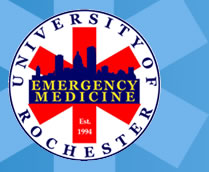This website provides the resources and results associated with the AHRQ-funded research program aimed at increasing the use of clinical pharmacists in emergency medicine. The project goals include providing a body of evidence to demonstrate the value of using emergency pharmacists in the emergency department.
 The Emergency Pharmacist Research Center
The Emergency Pharmacist Research CenterPartnerships in Patient Safety, Grant no. 1 U18 HS015818
The American Society of Health-System Pharmacists is providing a FOURTH year of the ASHP Patient-Care Impact Program for 2010, a 6-month, practice-based mentorship program for emergency pharmacists or those starting new clinical pharmacy programs in an emergency department. The 2010 class has been accepted, and the kickoff will occur at the June ASHP meeting in Tampa.
new!! In related news, we have recently co-authored a paper describing the first year of the PCIP Emergency Pharmacist program, in the American Journal of Health System Pharmacy. [link to article] (access required), or email us to request reprint.
new!! Dr. Hays recently co-authored a paper published in the Advanced Emergency Nursing Journal illustrating the benefits of a pharmacist in the ED. [link to article]
See the Publicity Page for new relevant journal articles and news items regarding emergency pharmacist programs in the news.
-
new!! Members of the research team, lead by Nicole Acquisto, PharmD, were recently awarded a "Hospital Pharmacist-Emergency Physician Collaboration Grant from the ASHP Foundation to study The Value of MRSA Nares Carriage Status for Treatment of Skin and Soft Infections in the Emergency Department. This Emergency Pharmacist
-
new!! Dr. Fairbanks was featured in an ASHP TV network interview during the ASHP Midear Meeting. To see the interview, click on "Human Factors Engineering and Medication Safety" in the Wednesday group: [link to interview]
-
Members of the research team, lead by Nicole Acquisto, PharmD, were awarded the 2008 ASHP Best Practices Award for their work demonstrating the impact of the Emergency Pharmacist on acute coronary syndrome patients in the emergency department.
-
Pharmacy Practice News article appears in the January 2009 issue and describes Dr. Acquisto's work as well as successes at other programs.
-
Emergency Pharmacist programs and our research were featured in the May/June 2008 edition of American Journal of Medical Quality, in an article written by Carolyn Clancy, MD, Director of AHRQ. See the Publicity Page for links to the article.
-
Pharmacy Practice News January 2008 edition provides an excellent overview of the ASHP December presentation summarizing the results of the study. See the Publicity Page for links to the article.
-
Our program was featured on AHRQ's podcast program "Healthcare 411." See the Publicity Page for links to the program.
Recent Additions to the Resources and Toolkit page:
-
Our paper describing the penetration of clinical pharmacy services in academic emergency departments was published in the March 2009 edition of the American Journal of Health-System Pharmacy. See link to article in the Resources and Toolkit page
-
A comprehensive list of Emergency Pharmacist related references from Australia has been posted. See bottom of the Resources and Toolkit page in the "relevant references" section.
-
Presentation given in Las Vegas on Wednesday, December 5, 2007 as part of a session "Current Clinical Practice in Emergency Pharmacy" at the ASHP Mid-Year Clinical Meeting 2007. Download the talk from the Resources and Toolkit page.
-
Study finds that emergency physicians and nurses highly value the role of an Emergency Pharmacist and feel they improve medication safety and quality of care. A manuscript describing ED staff perceptions of the Emergency Pharmacist role has been published in in the Emergency Medicine Journal. link to abstract (email us for a reprint). [related quotes from staff [pdf]
-
Powerpoint slides available to assist hospitals, pharmacists, and emergency departments in their efforts to describe, justify, and implement new Emergency Pharmacist programs. These tools are a direct result of efforts funded by the Agency for Healthcare Research and Quality. Please refer to the Resources and Toolkit page.
-
Download audience response results from the San Francisco the ASHP Summer Meeting session on Emergency Pharmacists, held Monday, June 25th, 2007, 2pm-5pm. See the Resources and Toolkit page.
Involvement of clinical pharmacists in patient care in the inpatient hospital setting has been shown to result in safer and more effective medication use. These pharmacists are involved in assuring appropriate prescribing and administration, monitoring patient adherence to therapy, providing drug information consultation to providers, monitoring patient responses and laboratory values, and providing patient education.
Emergency department (ED)- based clinical pharmacy services are relatively rare. This is likely due to the unique and complex nature of the ED. The paucity of ED-based clinical pharmacy services is perplexing given that the 1999 Institute of Medicine report To Err is Human found that the ED had the highest rate of preventable adverse events among clinical environments studied, with a potential of 3.8 million events thought to be preventable each year.
Adverse drug events that occur in the ED are a significant public health problem in the US, particularly for the older adult patient population. Published reports have asserted that ED-based pharmacists have the potential to increase quality of care in the ED. But although this concept appears logical, no scientific study has been undertaken to demonstrate that these programs reduce preventable adverse drug events and improve quality of care in the ED.
This project borrows ideals from the human factors engineering/safety science “systems approach” by allowing specialization of services and adding layers of redundancy to help prevent medication errors from effecting the patients.